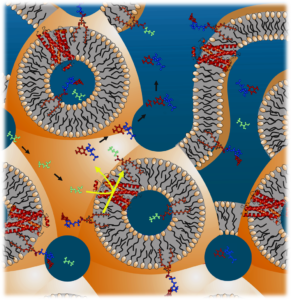 prof. Martin Caffrey
prof. Martin Caffrey
Membrane Structural and Functional Biology Group, Trinity College Dublin, Ireland
 One of the primary impasses on the route that eventually leads to membrane protein structure through to activity and function is found at the crystal production stage. Diffraction quality crystals, with which an atomic resolution structure is sought, are particularly difficult to prepare when a membrane source is used. The reason for this lies partly in our limited ability to manipulate proteins with hydrophobic/amphipathic surfaces that are usually enveloped with membrane lipids. More often than not, the protein gets trapped as an intractable aggregate in its watery course from membrane to crystal. As a result, access to the structure and thus function of tens of thousands of membrane proteins is limited. The health consequences of this are great given the role membrane proteins play in disease; blindness and cystic fibrosis are examples.
One of the primary impasses on the route that eventually leads to membrane protein structure through to activity and function is found at the crystal production stage. Diffraction quality crystals, with which an atomic resolution structure is sought, are particularly difficult to prepare when a membrane source is used. The reason for this lies partly in our limited ability to manipulate proteins with hydrophobic/amphipathic surfaces that are usually enveloped with membrane lipids. More often than not, the protein gets trapped as an intractable aggregate in its watery course from membrane to crystal. As a result, access to the structure and thus function of tens of thousands of membrane proteins is limited. The health consequences of this are great given the role membrane proteins play in disease; blindness and cystic fibrosis are examples.
In contrast, a veritable cornucopia of soluble proteins has offered up their structure and valuable insight into function, reflecting the relative ease with which they are crystallized. There exists therefore a pressing need for new ways of producing crystals of membrane proteins. In this presentation, I will review the field of membrane protein crystallogenesis. Emphasis will be placed on crystallization approaches that make use of the lipidic systems. In my talk, I will describe these methods and our progress in understanding how they work at a molecular level. The practicalities of implementing these methods in low- and high-throughput modes will be examined. A practical demonstration of the lipid cubic phase or in meso method will be provided.
Recommended reading:
- Caffrey, M. 2015. A comprehensive review of the lipid cubic phase or in meso method for crystallizing membrane and soluble proteins and complexes. Acta Cryst. F71, 3-18. https://doi.org/10.1107/S2053230X14026843
- Caffrey, M. 2021. Membrane protein crystallization. In Bergfors T. M. (ed.) Protein Crystallization. 3rd Edition (Ebook), IUL Biotechnology Series, 10. Chapter 19, pp 373-410. ISBN: 978-0-9720774-7-7. eBook
- Caffrey, M., Cherezov, V. 2009. Crystallizing Membrane Proteins In Lipidic Mesophases. Nature Protocols. 4:706-731.
(PMID: 19390528) https://www.nature.com/articles/nprot.2009.31 - Caffrey, M., Porter, C. 2010. Crystallizing membrane proteins for structure determination using lipidic mesophases. Vis. Exp. 45: www.jove.com/index/details.stp?id=1712, (doi: 10.3791/1712)
- Lab Publications: https://www.tcd.ie/Biochemistry/research/caffrey/publications/
